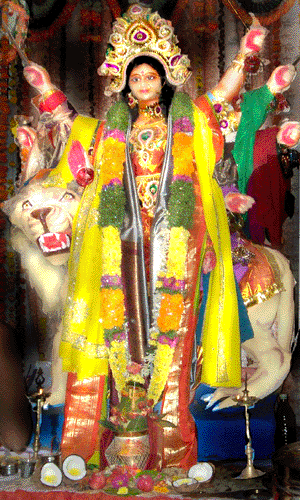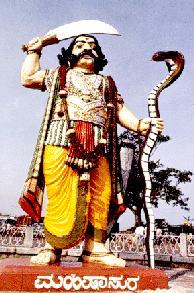DASARA FESTIVAL
(description of dasara festival in India and its old roots) During Winter the popular DASARA festival is celebrated. It lasts for ten days.
Like everybody else, Indians love celebrations and festivals. Most of the festivals in India are linked to the agricultural calendar. Many are actually harvest festivals or those signifying a change in the season. Each region has its own local festivals, besides the all India ones. One important festival celebrated all over India is Dasara , Dassara, or Dussehra. It is also called Nava ratri or nine nights festival.
The origin of this festival is not clearly known, but it would appear its roots reach back to staggeringly ancient times. It is essentially a mother goddess celebration.Traces of this festival are seen all the world over although they may be hidden under some other layers. Essentially it is a sort of thanksgiving to Nature in various forms.
 Legends
Legends
There are many legends connected with Dasara. As one legend goes, eons ago humans were not very prominent as they are now. Non human beings called Devas " Shining ones" ( resembling the gods of ancient Greece) were rivals of another group of beings called Asuras. Now some of the Asuras were very powerful and ambitious, and continually plotted to defeat the Gods and take their place . In one episode , an Asura called Mahisha, who looked like a buffalo, grew very powerful .
Under his leadership the Asuras even defeated the Devas , all of whom were powerless including Brahma, Vishnu, etc. Finally, when the world was reeling under Mahisha asura's tyranny, the Devas came together. Each contributed their individual energy to form a single mass of incandescent energy .
 Energy in Indian languages is called Shakti . This Shakti coalesced in the form of a radiant young virgin (Durga) . She took on Mahisha and the battle raged for nine days and nights. Finally on the tenth day the evil demon Mahisha was defeated . Durga is said to ride on a lion , who assisted her in destroing Mahisha . The power of of the mother goddess is symbolised by ten hands and many weapons.( Mahisha preferred to use a club).
Energy in Indian languages is called Shakti . This Shakti coalesced in the form of a radiant young virgin (Durga) . She took on Mahisha and the battle raged for nine days and nights. Finally on the tenth day the evil demon Mahisha was defeated . Durga is said to ride on a lion , who assisted her in destroing Mahisha . The power of of the mother goddess is symbolised by ten hands and many weapons.( Mahisha preferred to use a club).
Since the tale obviously narrates the eventual triumph of good over evil, it has been very popular down the ages.
Durga is the prehistoric mother goddess. In fact under the rustic celebrations and rituals lies a sophisticated view of the cosmos, which is articulated quite clearly even by simple villagers. Durga, or Shakti, synonymous with energy, is none other than the great power of Nature, which brings to birth, nourishes, preserves and at the appropriate time, merges everything back in herself. Anyone into ecology and environment can immediately get the point of Dasara.
For nine days and nights, the festival is celebrated. Shrines are cleaned up and services are performed. Open air stages are usually erected and a variety of entertainments enlivens the cool nights. In many parts of the country, notably Bengal, Karnataka, Maharashtra and Andhra Pradesh, clay idols depicting Durga finishing off the wicked demon Mahisha are installed . After the celebrations are over on the 10th day the idols are cermonially taken to the nearest river, beach, lake or even well and immersed into the waters.
Durga Pooja
The "Durga pooja" celebrations are mammoth in scale, particularly in Bengal. Each locality, ward, or organisation sets up its own pandal -- an enclosure, which is visited by thousands . In the evenings the fun starts with various cultural programs like plays, orchestras, dance shows and the like being staged.
On each day the legends are recited, incense and lighted camphor are waved in front of the statues, bouqets and garlands of fresh flowers and placed. In some areas, goats are ritually sacrificed. This however is gradually becoming less popular. Nowadays coconuts or pumpkins are ritually broken instead.
Aayoodha Pooja
On the eighth day, Aayoodha Pooja is celebrated. Aayoodha means weapons. Everybody brings out their implements and ritually respect the tools by which they make their living. Farmers place ploughshares and sickles : soldiers used to shine their swords and decorate them ( now they they polish their guns and rifles) : students bring their textbooks, accountants their pens and erasers while blacksmiths polish their hammers. Nowadays factory workers festoon their machines with flowers and sprinkle yellow turmeric rice and red ochre powder. Bus drivers gaily decorate their vehicles with green branches and orange flowers. In some computer bureaus the terminals are discreetly daubed with turmeric and red ochre. A plate with a bit of burning camphor is lit and waved in the air. Everyone solemnly pays their respects to the tools they use to earn their daily bread. (A sort of prehistoric labor day or May day) .
This is very significant because it is one of the few instances in old society where work or effort has been emphasised. In the old days learning reading and writing was difficult and open only to a few: the writers were far removed from the life of the common folk, so "work" rarely entered their writings. This includes religious writings too. It is possible the web writers of today will follow the same path.
Vijaya dashami
On the last day, called Vijaya Dashami,(the tenth day of victory) big celebrations are held. Then a procession is taken out to immerse the idols into the waters. Until some centuries ago, it was traditional for armies to start their campaign on Vijaya Dasami day. It is generally considered a very good day to start any new venture.
back to index of culture spots and events
© V Ramchandra Rao ..all rights reserved.
updated mar 2004
e mail vramrao@yahoo
originally published in 1995 on stph.net
 Legends
Legends Energy in Indian languages is called Shakti . This Shakti coalesced in the form of a radiant young virgin (Durga) . She took on Mahisha and the battle raged for nine days and nights. Finally on the tenth day the evil demon Mahisha was defeated . Durga is said to ride on a lion , who assisted her in destroing Mahisha . The power of of the mother goddess is symbolised by ten hands and many weapons.( Mahisha preferred to use a club).
Energy in Indian languages is called Shakti . This Shakti coalesced in the form of a radiant young virgin (Durga) . She took on Mahisha and the battle raged for nine days and nights. Finally on the tenth day the evil demon Mahisha was defeated . Durga is said to ride on a lion , who assisted her in destroing Mahisha . The power of of the mother goddess is symbolised by ten hands and many weapons.( Mahisha preferred to use a club).